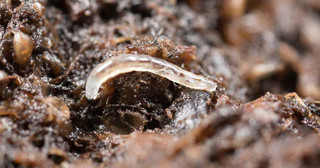How Do I Know if I Have Fungus Gnats?
Fungus gnats are a common pest in many facilities, establishing in the growing media and wherever moisture and debris accumulate. They resemble tiny mosquitoes and can usually be found crawling or flying low near the growing media or floor.
Fungus gnat adults are identifiable by their long legs, transparent wings, and affinity for nutrientrich, moist soils. You might notice these tiny flies buzzing around plant containers. Still, you won't see them munching on the plant's foliage directly, like some more harmful pests do. While they don't typically pose a serious threat to crops, they can be a nuisance to employees and may spread soil-borne plant diseases.
Fungus gnat larvae are small, worm-like insects mostly measuring less than 1/2 inch long. The fungus gnat larvae feed on fungus and decaying matter in moist soil and plant pots where fungus and fungus spores thrive.
What Does Fungus Gnat Damage Look Like?
Although their common name implies otherwise, fungus gnats do not feed off or require fungus to grow. Instead, these tiny pests get their nourishment by eating bits of organic material (such as plant roots or decaying leaves) and nourishing fungi while they live.
In small numbers, fungus gnats are more of an annoyance than anything. The adult gnats don't actively harm plants or people. However, if their population gets out of hand, the larvae may start feeding on plant roots, causing notable damage. This is especially bad for young plants, such as seedlings, with only a few delicate roots. In addition, fungus gnat larvae and adults can cause indirect damage transferring fungal diseases such as Verticillium, Fusarium, and Botrytis.
Will Fungus Gnats Go Away On Their Own?
Fungus gnat populations will remain wherever moisture and debris accumulate. Growing media is their preferred environment as it is rich in nutrients and remains constantly moist. They will not typically go away on their own unless the environment changes drastically.
In order to limit their populations, keep your facility clean of debris and pooling water, paying particular attention to drains and cracks in concrete, which can become breeding grounds for fungus gnats. Treating regularly with a beneficial nematode species like Steinernema feltiae will limit their ability to reproduce in your facility.
How Do You Get Rid of Fungus Gnats?
Prevention is by far the best cure. First, make sure the soil has good drainage and let it dry out between waterings. Avoid overwatering or allowing water to collect at the bottom of containers. If you have infestations already, use sticky traps to deal with flying adults. Entomopathogenic nematode Steinernema feltiae will actively search for fungus gnat larvae and kill them.
Are Fungus Gnats Harmful?
While adult fungus gnats do not directly feed on living crops, the larvae feed on plant roots which can cause stunting of plant growth. Both life stages can spread soil-borne diseases such as Pythium, Rhizoctonia, Fusarium, etc., quickly throughout a crop. In the worst situations, their numbers can grow to a point where employees inhale the insect during crop activities.
Where Are The Gnats Coming From?
Growing media is an excellent environment for Fungus gnat populations to thrive. Additionally, cracks in the floor, drain pipes, and other small crevices in your facility that accumulate debris and moisture serve as a perfect breeding environment for this pest.
How do Nematodes Kill Fungus Gnats?
Steinernema feltiae nematodes kill fungus gnats by eating the soft tissue of a fungus gnat larva and releasing symbiotic bacteria into its body cavity. The nematodes enter through the pest's cavities and live inside of it, developing and reproducing. After being infected, the host larva dies within a few hours to days due to the release of deadly toxins in the symbiotic bacteria.



